Multi-Dimensional Recurrent Neural Networks
Multi-Dimensional Recurrent Neural Networks
The basic idea of MDRNNs is to replace the single recurrent connection found in standard RNNs with as many recurrent connections as there are dimensions in the data. During the forward pass, at each point in the data sequence, the hidden layer of the network receives both an external input and its own activations from one step back along all dimensions.

Clearly, the data must be processed in such a way that when the network reaches a poin in an n-dimensional sequence, it has already passed through all the points from which it will rechive its previous activations.
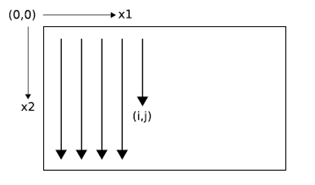
2D sequence ordering. The MDRNN forword pass starts at the origin and follows the direction of the arrows. The point(I,j) is never reached before both (i-1,j) and (i,j-1)
The forward pass of an MDRNN can then be carried out by feeding forward the input and the n previous hidden layer activations at each point in the ordered input sequence, and storing the resulting hidden layer activations at each point in the ordered input sequence, and storing the resulting hidden layer activations. Care must be taken at the sequence boundaries not to feed forward activations from points outside the sequence.
Note that each 'point' in the input sequence will in general be a multivalued vector. For example, in a two dimensional color image, the inputs could be single pixels represented by RGB triples, or blocks of pixels, or the outputs of a preprocessing method such as a discrete cosine transform.
The error gradient of an MDRNN(that is, the derivative of some objective function with respect to the network weights) can be calculated with an n-dimensional extension of the backpropagation through time(BPTT) algorithm. As with one dimensional BPTT, the sequence is processed in the reverse order of the forward pass. At each timestep, the hidden layer receives both the output error derivatives and its own n 'future' derivatives. Figure 2 illustrates the BPTT backword pass for two dimensions. Again, care must be taken at the sequence boundaries.
At a point in an n-dimensional sequence, define and respectively as the activations of the input unit and the hidden unit. Define as the weight of the connection going from unit j to unit k. Then for an n-dimensional MDRNN whose hidden layer consists of summation units with the tanh activation function, the forward pass for a sequence with dimensions can be sumarised as follows:

Defining and respectively as the derivatives of the objective function with respect to the activations of the output unit and the hidden unit at point x, the backward pass is:
Since the forward and backward pass require one pass each through the data sequence, the overall complexity of MDRNN training is linear in the number of data points and the unmber of network weights.
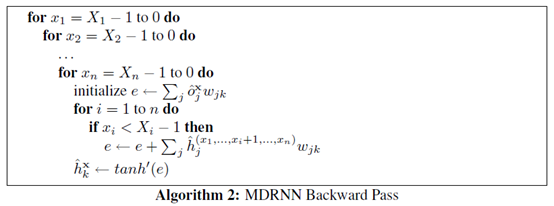
Multi-directional MDRNNs
For one dimensional RNNs, the problem of multi-directional context was solved in 1997 by the introduction of bidirectional recurrent neural networks (BRNNs). BRNNs contain two separate hidden layers that process the input sequence in the forward and reverse directions. The two hidden layers are connected to a single output layer, thereby providing the network with access to both past and future context.
BRNNs can be extended to n-dimensional data by using separate hidden layers, each of which processes the sequence using the ordering defined above, but with a different choice of axes.
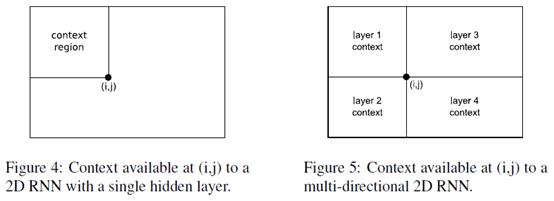
More specifically, the axes are chosen so that their origins lie on the the vertices of the sequence. The 2 dimensional case is illustrated in Figure 6.

As before, the hidden layers are connected to a single output layer, which now has access to all surrounding context.
If the size of the hidden layers is held constan, multi-direcitonal MDRNNs scales as O() for n-dimensional data. In practive however, we have found that using small layers gives better results than 1 large layer with the same overall number of weights, presumably because the data processing is shared between the hidden layers. This also holds in one dimension, as previous experiments have demonstrated. In any case the complexity of the algorithm remains linear in the number of data points and the number of parameters, and the number of parameters is independent of the data dimensionality.
For a multi-directional MDRNN, the forward and backward passes through an n-dimensional sequence can be summarized as follows:


MCGSM
We factorize the distribution of images such that the prediction of a pixel(black) may depend on any pixel in the upper-left green region.
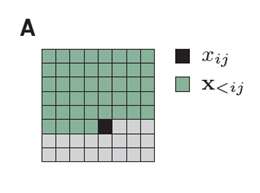
A graphical model representation of an MCGSM with a causal neighborhood limited to a small region.
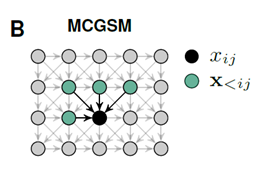
A visualization of our recurrent iamge model with two layers of spatial LSTMs. The pixels of the image are represented twice and some arrows are omitted for clarity. Through feedforward connections, the prediction of a pixel depends directly on its neighborhood(gre-e),but through recurrent connections it hs access to the information in a much larger region(r-ed).
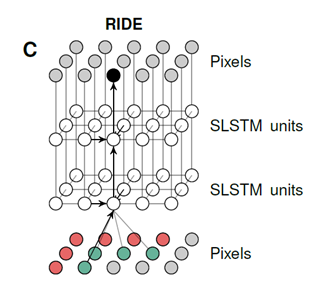
Multi-Dimensional Recurrent Neural Networks的更多相关文章
- The Unreasonable Effectiveness of Recurrent Neural Networks (RNN)
http://karpathy.github.io/2015/05/21/rnn-effectiveness/ There’s something magical about Recurrent Ne ...
- 循环神经网络(RNN, Recurrent Neural Networks)介绍(转载)
循环神经网络(RNN, Recurrent Neural Networks)介绍 这篇文章很多内容是参考:http://www.wildml.com/2015/09/recurrent-neur ...
- Attention and Augmented Recurrent Neural Networks
Attention and Augmented Recurrent Neural Networks CHRIS OLAHGoogle Brain SHAN CARTERGoogle Brain Sep ...
- cs231n spring 2017 lecture10 Recurrent Neural Networks 听课笔记
(没太听明白,下次重新听一遍) 1. Recurrent Neural Networks
- 第十四章——循环神经网络(Recurrent Neural Networks)(第一部分)
由于本章过长,分为两个部分,这是第一部分. 这几年提到RNN,一般指Recurrent Neural Networks,至于翻译成循环神经网络还是递归神经网络都可以.wiki上面把Recurrent ...
- 第十四章——循环神经网络(Recurrent Neural Networks)(第二部分)
本章共两部分,这是第二部分: 第十四章--循环神经网络(Recurrent Neural Networks)(第一部分) 第十四章--循环神经网络(Recurrent Neural Networks) ...
- Pixel Recurrent Neural Networks翻译
Pixel Recurrent Neural Networks 目前主要在用的文档存放: https://www.yuque.com/lart/papers/prnn github存档: https: ...
- 循环神经网络(Recurrent Neural Networks, RNN)介绍
目录 1 什么是RNNs 2 RNNs能干什么 2.1 语言模型与文本生成Language Modeling and Generating Text 2.2 机器翻译Machine Translati ...
- 《转》循环神经网络(RNN, Recurrent Neural Networks)学习笔记:基础理论
转自 http://blog.csdn.net/xingzhedai/article/details/53144126 更多参考:http://blog.csdn.net/mafeiyu80/arti ...
随机推荐
- 【javascript类库】zepto和jquery的md5加密插件
[javascript类库]zepto和jquery的md5加密插件 相信很多人对jQuery并不陌生,这款封装良好的插件被很多开发者使用. zepto可以说是jQuery在移动端的替代产品,它比jQ ...
- 解决Mysql导入大数据出现gone away的问题
在用Mysql Yog或者PHPMyadmin等工具导入数据量大的sql文件时,会提示“gone away”,那么如何处理这个问题尼? 在Mysql对应的配置文件中my.ini文件中加入以下配置: # ...
- 【虚拟机-网关】如何在使用应用程序网关和 Nginx 的环境下实现强制 HTTPS 跳转
背景介绍 大家在使用 Nginx 部署网站时,实现 HTTP 到 HTTPS 的强制跳转是非常容易的事情,一般可以使用rewrite 命令或者使用返回自定义 301 页面的方法对 HTTP 请求进行 ...
- Python+selenium之Page Object设计模式
Page Object是selenium自动化测试项目开发实践的最佳设计模式之一,他主要提现在对界面交互细节的封装,这样可以使测试案例隔你给加关注于业务而非界面细节,从而提高测试案例的可读性. Pag ...
- JavaScript_5_对象
1. JavaScrip中所有事物都是对象:字符串.数字.日期.等等 2. 在javaScripe中,对象是拥有属性和方法的数据 <!DOCTYPE html> <html> ...
- 打开某exe提示"应用程序无法启动,因为应用程序的并行配置不正确……"的解决方案
本人在新安装好了的windows server 2008 r2 (64位)上运行“RefilesName V2.0(文件批量改名).exe”,结果提示: 应用程序无法启动,因为应用程序的并行配置不正确 ...
- CentOS更改时区
1.编辑文件 vi /etc/sysconfig/clock 修改内容 ZONE="Asia/Shanghai" 2.覆盖旧时区文件 cp /usr/share/zoneinfo/ ...
- 天坑之mysql乱码问题以及mysql重启出现1067的错误解决
相信很多小伙伴都遇到过数据库中文乱码问题,很头疼,明明Navicat上的编码格式都是utf-8是一样的啊? 为什么还是乱码? 原因是Navicat上的数据库编码格式并不是真正的编码格式 ,所以明白了吗 ...
- Pig Latin-freecodecamp算法题目
Pig Latin 1.要求 Pig Latin把一个英文单词的第一个辅音或辅音丛(consonant cluster)移到词尾,然后加上后缀 "ay". 如果单词以元音开始,你只 ...
- Python爬虫系列-Selenium+Chrome/PhantomJS爬取淘宝美食
1.搜索关键字 利用Selenium驱动浏览器搜索关键字,得到查询后的商品列表 2.分析页码并翻页 得到商品页码数,模拟翻页,得到后续页面的商品列表 3.分析提取商品内容 利用PyQuery分析源码, ...
